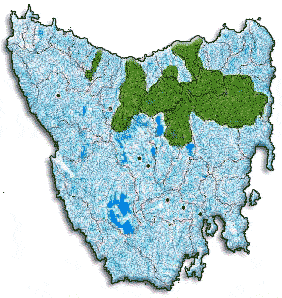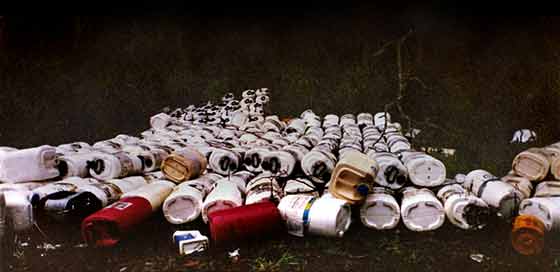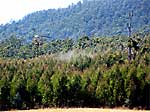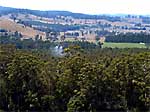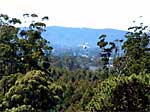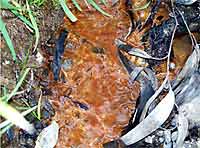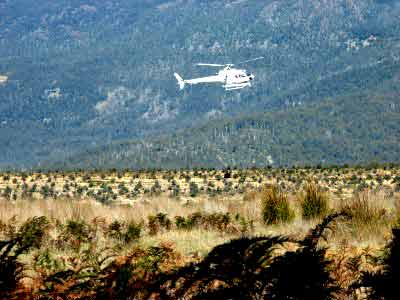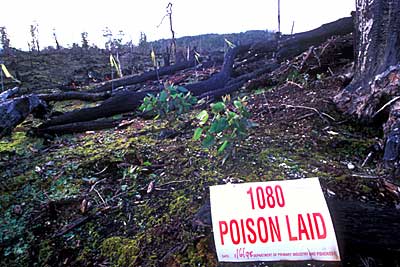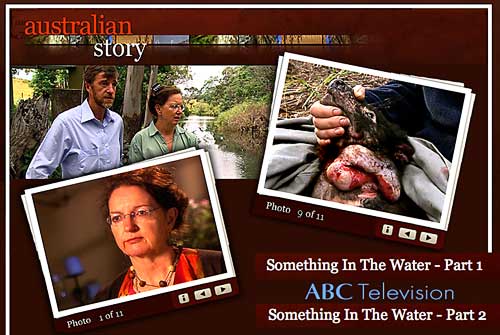|
WATER S.O.S TASMANIA - Chemicals
|
|
|
 |
Chemical
Contamination
of Water Catchments
|
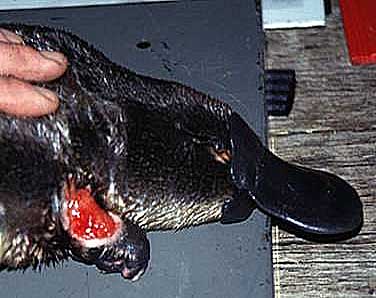 |
|
|
|
|
|
The continued use of chemicals for the suppression
of “woody weeds” (i.e. native forest regrowth), in
plantation establishment together with phosphate, nitrogenous
fertilisers and 1080 baits, claimed to be essential for
economic timber production, pose a real threat to the
potability of water, human and animal health.
|
|
SOME AERIAL SPRAYING
OF POISONS IN WATER CATCHMENTS - images courtesy
Peter Godfrey
|
|
|
|
|
|
|
|
Testing by Tasmania's
Environment Protection Authority has confirmed elevated
heavy metal levels [arsenic and lead] in water from the
backyards of West Coast's Rosebery residents who have
fallen ill.
|
|
|
|
|
|
With the latest State Governments
water tests revealing chemical contamination of many
water bodies in the state, it is time that the Government
now realises that their legislation is facilitating
pollution and failing communities.
|
|
Atrazine and Simazine
Dr. Alison Bleaney OBE
|
|
Atrazine and simazine work by disrupting
our hormone (endocrine) and enzyme systems and allowing
other chemicals to act and pre-set our bodies for some
illnesses and cancers. The type and severity of the
effects depends on the time that they affect us but
especially when in utero or as a child. Hormone disruptors
work at extremely low concentrations i.e. 10-6
up to 10-10 (10-6 is the same
as 1 part per billion (1ppb)). They also upset our immune
system and are very strong skin sensitisers i.e. are
allergenic, and alter the functioning of our genes i.e.
cause epigenetic changes. Atrazine and simazine are
among the strongest of the environmental oestrogens
(EO), which are also strong allergy modifiers, and the
effects of EO's are additive. Atrazine and simazine
have been shown to cause chemical castration of male
frogs and other animals at 0.1 ppb, by induction of
an enzyme (aromatase) which changes testosterone into
oestrogen. The hormones in frogs are identical to those
in humans (see below - What is Atrazine?). The effects
are apparent in the next 2 generations, even when only
the pregnant mother was exposed to these chemicals.
The Australian Drinking Water Guidelines allows atrazine
to be present up to 40ppb in our drinking water i.e.
400 times the concentration required to castrate these
animals. The total biological effects of these and other
toxic herbicides on all the animals in our ecosystems
including humans have not been fully investigated let
alone quantified.
|
|
Pyrethroids
|
Endocrine disrupting
chemicals in our drinking water - Dr Alison Bleaney
|
Since 2005, atrazine has
been found in the Duck River, the Jordan River,
the Rubicon River, the Liffey River, and the
Derwent River. Simazine has been found in the
Brid River, the Montague River, the Prosser
River, the Rubicon River, the South Esk River
and Trevallyn Dam, the Macquarie River (contaminated
with simazine from July 2007 until January 2008,
with no data available since that month), Brumbys
Creek, and Western Creek. Launceston’s
water supply reported simazine in 2003 and 2004
at above guideline values and atrazine at above
guideline value in 2001.
|
|
|
|
|
|
|
The above link goes to a Department
of Primary Industries & Water (DPIW Tasmania) testing
program for 19 pesticides. Only parent chemicals
are tested for (no degradation products, or excipients
i.e. surfactants, wetting or others) in water from 54
rivers in Tasmania taken at the very bottom of the catchments
(a maximum dilution effect). Remember, this testing
only started in 2005 and that up until then there had
been almost no monitoring of rivers for pesticides.
The effects of chemical mixtures - lipid and water soluble
are unexpected and unpredictable and are not tested
for by our Federal or State regulators before they are
allowed to be used. The effects of pesticides / chemicals
are most pronounced on the foetus followed by
the child, the immunocomprimised and the
elderly. The same holds true for animals.
|
|
|
|
|
|
|
|
The following are extracts from
the Institute of Foresters of Australia (IFA)
(www.forestry.org.au), Forestry Policy Statement
No. 2.5 titled, Use of Chemicals in Plantation
Forestry:
|
|
•
|
"....strict environmental
standards (including the use of buffer zones)
can be applied to ensure chemicals are accurately
applied and remain within recommended application
zones".
|
|
•
|
“Chemical application
techniques in forestry are constantly being
refined. Sophisticated application technology
(including micronair nozzles) is used to control
herbicide droplet size and minimize drift”.
|
|
|
|
|
|
|
Westerns rivulet has been threatened by a
cocktail of chemicals, Lontrel, Verdict and Hasten. A brief
web search of Verdict reveals it is toxic to fish, platypus
and small birds. It is of the chemical family Aryloxy-Phenoxys,
which in turn are a sub family of aromatic carboxylic acids
which include chemicals such as 24D.
While there are guidelines for individual chemical usage, there
are no guidelines regarding the synergistic effects of mixing
a number of chemicals or surfactants, which is a common practice.
Atrazine and Symazine, just two of the triazinine group of chemicals,
are used widely throughout Australia, they have been banned
in a number of European countries as they are known to be oestrogenic
and can disrupt the normal development of reproductive organs,
they are also classified as possible carcinogens.
|
|
|
While 1080, a colorless, odourless,
highly toxic chemical has been banned in the U.S.A. since
1974, it is still widely used throughout Australia.
|
|
|
|
|
Research has shown a marked decrease in sperm
counts amongst forestry and farm workers who are continually
handling chemicals.
Minute amounts of chemicals from Synthetic Oestrogens in the
contraceptive pill to pesticides and detergents, which are known
to be endocrine disrupting chemicals, have affected the hormone
system of male fish and changed their sex.
There is significant scientific opinion that the use of broad
spectrum chemicals together with widespread land clearing in
forestry and farming are contributing largely to unbalanced
ecologies and the loss of their bio-diversity.
Soil organisms and fungi help act as an immune system for plants
against diseases and insects, when chemicals and fertilisers
are used in the simplified systems of mono-cultures, then even
more chemicals are needed in an increasing vicious cycle.
[Wolfe 2001]
|
|
|
|
|
|
| Further
Ref: |

Status of Tasmanian Mammals - David Obendorf
Whelan JJ, Willis K. Problems with provision:
barriers to drinking water quality and public health in rural Tasmania,
Australia.
Rural and Remote Health 7 (online), 2007: 627.
Available from : RURAL
and REMOTE HEALTH - www.rrh.org.au
Davies, P.E., L.S.J. Cook and J.L. Barton 1994.
Aust. J.Mar. Freshwater Res., 1994, 45, 209-26
Environment and Heritage Report
2005.
Australian Toxic Networks Submission
to:-
The Australian Pesticides and Vetinary Medicines Authority.
|
|
|
|
|
